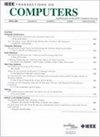超图处理的重新排序与压缩
IF 3.8
2区 计算机科学
Q2 COMPUTER SCIENCE, HARDWARE & ARCHITECTURE
引用次数: 0
摘要
超图可有效模拟多元关系,因此适用于社会传染、在线群组和蛋白质结构等多个领域。然而,超图的规模越来越大,导致计算成本越来越高,因此需要高效的加速策略。现有方法通常需要考虑特定算法的问题,因此难以直接应用于任意超图处理任务。在本文中,我们提出了一种涉及超图重新排序的压缩阵列加速策略,以提高内存访问效率,该策略可应用于各种超图处理任务,而无需考虑算法本身。我们引入了一种名为 "接近度 "的新度量来优化一维数组表示中顶点和超图的排序。此外,我们还提出了一种 $\frac{1}{2w}$ 近似算法来获得顶点和超边的最优排序。我们还为动态超图开发了一种高效的更新机制。我们的大量实验证明,超图处理性能有了显著提高,高速缓存缺失减少,内存占用降低。此外,我们的方法可以集成到现有的超图处理框架(如 Hygra)中,以提高其性能。本文章由计算机程序翻译,如有差异,请以英文原文为准。
Reordering and Compression for Hypergraph Processing
Hypergraphs are applicable to various domains such as social contagion, online groups, and protein structures due to their effective modeling of multivariate relationships. However, the increasing size of hypergraphs has led to high computation costs, necessitating efficient acceleration strategies. Existing approaches often require consideration of algorithm-specific issues, making them difficult to directly apply to arbitrary hypergraph processing tasks. In this paper, we propose a compression-array acceleration strategy involving hypergraph reordering to improve memory access efficiency, which can be applied to various hypergraph processing tasks without considering the algorithm itself. We introduce a new metric called closeness to optimize the ordering of vertices and hyperedges in the one-dimensional array representation. Moreover, we present an
$\frac{1}{2w}$
求助全文
通过发布文献求助,成功后即可免费获取论文全文。
去求助
来源期刊

IEEE Transactions on Computers
工程技术-工程:电子与电气
CiteScore
6.60
自引率
5.40%
发文量
199
审稿时长
6.0 months
期刊介绍:
The IEEE Transactions on Computers is a monthly publication with a wide distribution to researchers, developers, technical managers, and educators in the computer field. It publishes papers on research in areas of current interest to the readers. These areas include, but are not limited to, the following: a) computer organizations and architectures; b) operating systems, software systems, and communication protocols; c) real-time systems and embedded systems; d) digital devices, computer components, and interconnection networks; e) specification, design, prototyping, and testing methods and tools; f) performance, fault tolerance, reliability, security, and testability; g) case studies and experimental and theoretical evaluations; and h) new and important applications and trends.
 求助内容:
求助内容: 应助结果提醒方式:
应助结果提醒方式:


